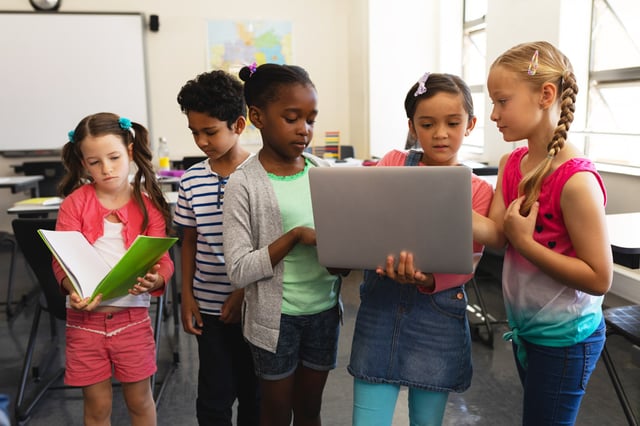This Educator Teaches Robotics to Prepare Students for Careers in STEM
 Insights By John Patrick Shell
Insights By John Patrick Shell
With technological advancement in areas like Artificial Intelligence, Machine Learning, and Robotics, what the future needs are inventors, problem solvers, and creative thinkers to develop solutions with these emerging technologies; informed users to cooperate with technology as it becomes more immersed in our lives, and ethical thinkers to regulate and ensure digital tools are used for good.
Develop. Cooperate. Regulate.
Rising to meet this need are educators like John Patrick Shell, an engineering teacher at CE Williams Middle School’s career readiness program. Through this program, Shell introduces students to cutting-edge technologies that are reshaping the future of work, with an emphasis on robotics.
Below are excerpts from our conversation.
Impactful Learning Experiences
When it comes to robotics, people can sometimes misconstrue it as a ‘fun’ activity rather than something that engages students in deep and relevant learning. How do you address this with students?
Robotics is a deep-thinking activity. When I introduce robotics, I often use a simple activity like brushing one’s teeth. I have students write down every step involved. They then must have someone complete that task using their partner’s instructions. When students realize that something as simple as putting toothpaste on a toothbrush requires many steps, they begin to make the connection that making a program requires a lot of work and patience.
Through this sort of work, what are some the transferrable skills students develop through studying robotics?
The life-long skills that immediately comes to mind are problem solving and collaboration. These are highly sought-after qualities that employers always want. I don’t see the need for these skills ever going away. If a student learns early how to analyze a problem and work with others well, the sky is the limit!
You mention that you include topics like ethics, ecology, and history in your class. Can you provide some examples?
I have a group project that students complete on various types of robots (Military, Assistive, Underwater, Medical, and Exploration). In the presentation, students must look at the history of their robot of choice, create a timeline of how that robot has changed, and explain how that robot impacts society currently and how they think that robot will impact their future.
In addition, they also must answer what it means to give up control to a machine. There have been some interesting discussions about ethics and robotics. One that comes to mind is what happens if robots become self-aware.
Authenticity & Career Readiness
What are the ways in which robotics translates into career readiness? Is there a specific career path for students in your class?
Not to the extent that all of my learners will become engineers, but they do learn about a variety of engineering, STEM, and CTE career choices that may interest them. They also learn how these careers will shape their adult life and future.
What I try to get students to understand about robots is that they are incredibly powerful, complex machines, which will be intertwined in their future education and career prospects. For example, robots are used to access to places that are otherwise inaccessible to the human population. Robots protect humankind from danger by performing tasks that are harmful to our health. They enhance the quality of our lives by performing tedious jobs and assisting people with disabilities.
The way that robotics has and will continue to shape their lives is astounding. The earlier students are able to understand the direction of robotics and able to use these robots to assist them in a variety of capacities, the more useful robotics will become for them.
What are some of the ways you integrate technology in your classroom to create authentic and immersive learning experiences?
Personally, my favorite integration of technology is in my aeronautics class. I use a flight simulator software for students to research the concepts of flight, engineer a glider, compete for the best flight time against each other, print out templates to build the glider, and build the glider out of balsa wood.
Students are able to use the technology to learn, create, and build. They use the technology to reach the highest level of Bloom’s Taxonomy. This experience redefines what students are able to see and do with technology in the classroom.
How do you measure efficacy in your class? Is there use of assessments?
My classes are project based. I try to give a real-world example of how engineers work and solve problems within the constraints of a project. I have a variety of assessments.
Within the projects, my assessments don’t fit the traditional quiz or test format. Instead, students have rubrics that evaluate group presentations and individual presentations on various concepts. Students also have independent learning and questions to answer about concepts taught. Students are encouraged to discuss answers to questions with classmates and share their answers with me in a discussion format.
The scores from these are then translated into numbers that fit the traditional grading scale. I try not to state whether an answer is right or wrong to a student but to encourage more research to find the information needed to adequately answer a particular question.
Amplifying Access to Robotics
With the benefits students derive from studying robotics, what advice would you give a teacher looking to address this topic in class or build a similar program?
I would encourage that teacher to provide field trip experiences to local businesses and industries that use robotics and have students discuss and reflect on those experiences.
I would also encourage the teacher to invite professionals that relate to the concepts being taught, to speak with the class and bring in activities to expand their educational horizons with real-world concepts. In addition, coordinate with local universities to find the latest advancements and incorporate those into a few lessons.
What are strategies to make robotics inclusive and accessible to all students?
I recently facilitated a summer underwater robotics program for all girls. I had female engineers come in and speak to the participating students about opportunities in STEM. By being a single gender experience, girls were very relaxed in participating and did much better with the concepts involving the build. I think that through having such an opportunity like that, girls are more likely to partake in a STEM-related field and benefit from it.
Final Thoughts
In working on this article, a colleague shared with me a quote from Kurt Vonnegut’s Cat’s Cradle that reads: "Science is magic that works."
While science can seem so elusive and intangible, robotics offers students a hands-on and immersive learning experience. This empowers students to study not only how robots have changed the human experience but also imagine new problems for robots to solve and develop the programs to do so. It’s about invention, critical thinking, and lifelong learning, which is something Shell really exemplified:
“I’m such a science fiction nerd. So many of the books and television shows that I read and watched as a kid made my mind wonder about what was possible. Robotics was officially introduced to me through a colleague who started a program at a school many years ago. I was asked if I wanted to try it. Kids actually taught me how to put together my first successful program and build. I was amazed at how much went into the process and how incredibly resourceful kids were. I was hooked with my first experience.”






